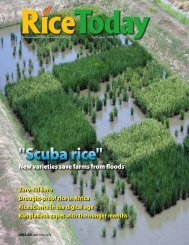Rice - adron.sr
Rice - adron.sr
Rice - adron.sr
Create successful ePaper yourself
Turn your PDF publications into a flip-book with our unique Google optimized e-Paper software.
variety, yet to be developed, thatseveral years later would turnrice production on its head:It would seem that the following plant typemight be useful in the near future throughoutmuch of the tropics—a combination ofshort, stiff culms bearing erect, moderatelysized, dark-green leaves; responsiveness inyield to fertilizer; mid-season maturity andin most cases, photoperiod sensitivity topermit double cropping practices. Theseobjectives are being pursued […] with bothindica by indica and indica by japonicahybridization.Not much was known aboutthe genetics of tropical ricevarieties at the time, so IRRIhired a geneticist—Te Tzu Chang,from Taiwan—in its first group ofscientists. Dr. Chang began studyingthe inheritance of plant height.Jennings made 38 crosses in late1962; 11 of them included the dwarfparent DGWG, TN1, or I-geo-tze(IGT)—another dwarf from Taiwan.The eighth IRRI cross—fromwhich IR8 was eventually selected—was of Peta, a tall, vigorous varietyfrom Indonesia, and DGWG.From that cross, 130 seeds wereformed. Those seeds were plantedin pots in IRRI’s screenhouseand produced the first, or F 1 ,generation of plants. All were tall.Seeds from the F 1 plants weresown in the field, and produced about10,000 second-generation (F 2 ) plantsthat segregated by height in a ratio ofthree talls to one dwarf. Dr. Jenningsimmediately recognized this as aMendelian ratio—named after GregorMendel, who became known as thefather of genetics for his 19th-centuryresearch into the inheritance of traitsin pea plants. This was a key result—itmeant that dwarfism in DGWGwas controlled by a single gene andwas therefore simply inherited,making the job of developing acommercially usable semidwarfvariety immeasurably easier.Dr. Jennings immediatelybrought Drs. Chandler and Wortmanto the field to see the segregatingplants. He then cabled the good newsto Dr. Beachell in Texas. “That’swhen we knew we had it [meaningthat DGWG could be used to breedan improved semidwarf variety],”Dr. Beachell recalled years later.With this discovery, Dr. Jenningspersuaded Drs. Chandler andWortman to exchange a cytogeneticsposition in the Varietal Improvementprogram for a second breeder tohelp with the increase in field workthat would obviously come. Theyagreed, and Dr. Jennings suggestedDr. Beachell, who arrived in 1963.Tall, late-maturing plantsfrom the Peta-DGWG cross werediscarded, and only short, earlymaturingplants were saved.Seeds were “bulked” and plantedin a nursery where they could bescreened for susceptibility to the riceblast fungus. In 1963, Dr. Jenningsdeparted IRRI for study leave,leaving the material in the hands ofnewly arrived Dr. Beachell. From thethird (F 3 ) generation, Dr. Beachellselected 298 of the best individualplants. Seeds from each plantwere sown as individual “pedigreerows”—the fourth (F 4 ) generation.From row 288, a singleplant—the third one—was selectedand designated IR8-288-3. Itsseeds, the F 5 or fifth generation,were grown to produce thebasic IR8-288-3 seed stock.IR8-288-3—which was eventuallynamed as variety IR8—was asemidwarf rice, about 120 cm tallwith strong stems that held theplant upright, even when heavilyfertilized. It was also nonsensitiveIRRI STAFF load IR8seeds for distributionto farmers in 1966.to photoperiod, or daylength,scientists would later learn. Thatmeant it could be grown in manylatitudes, at any time of the year.“The seed [of IR8] was uniformenough for trials in other countries,but a couple of years later Dr.Beachell devoted considerableeffort to producing an extremelypure strain that would serve asa uniform seed source of IR8 forthe future,” Dr. Chandler wrote.Meanwhile, seeds of IR8-288-3 and other promising lines werebeing sent for testing by nationalrice programs across Asia.“IRRI’s policy was free accessto all of our genetic material,”Dr. Beachell said. “It was madeavailable to the world.”In the 1966 dry season, S.K. DeDatta, a young Indian agronomistwho had joined IRRI in early 1964,examined the fertilizer responseof IR8, along with other ricevarieties. “We wanted to determinemaximum yields under the bestmanagement possible,” he said.Dr. De Datta was amazedwhen he harvested the trials inMay. IR8 averaged 9.4 tons perhectare, yielding as high as 10.3tons per hectare in one trial.Average yields in the Philippinesthen were about 1 ton per hectare.Dr. De Datta took his yielddata to Dr. Jennings, then toDr. Beachell. “Let’s go see Bob[Chandler],” Dr. Beachell said.But, at that moment, Dr.<strong>Rice</strong> Today October-December 200637IRRI
















